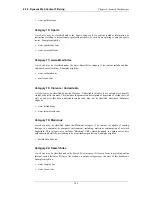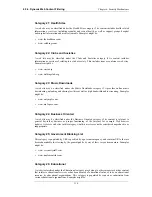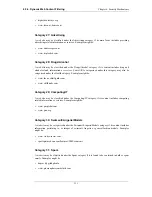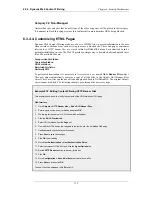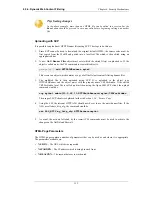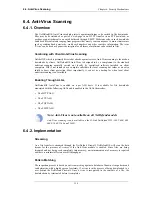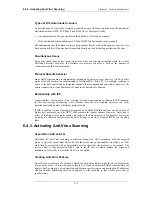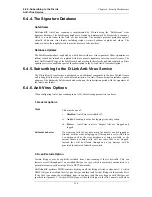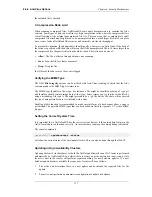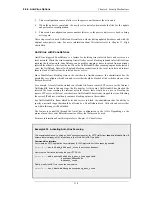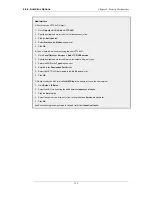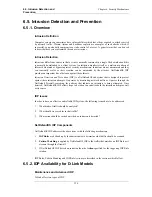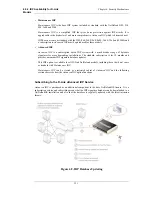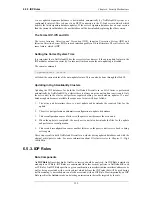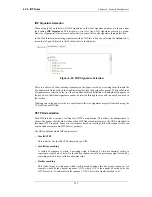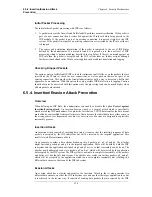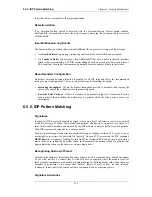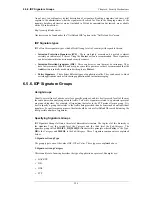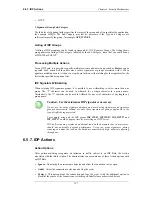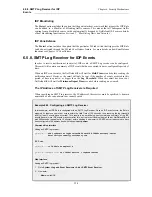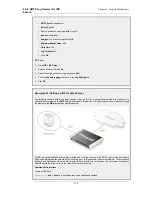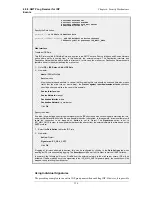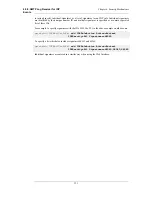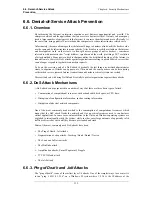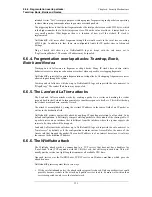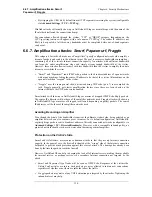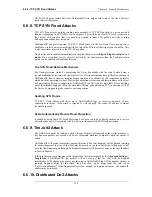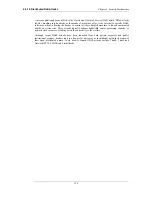
IDP Signature Selection
When using the Web Interface, all IDP signatures in the local signature database are shown under
the heading IDP Signatures. This displays a two level tree of all signatures ordered by group.
However, its purpose is for reference only and it is not possible to add signatures through this tree.
In the Web Interface, associating signatures with an IDP rule is done by selecting the Action tab. A
screenshot of part of this tab in the Web Interface is shown below.
Figure 6.10. IDP Signature Selection
There is a choice of either entering signatures in the upper text box or selecting them through the
tree underneath which collects the signatures together into their respective groups. When collections
of signatures are selected in the tree, the equivalent wildcard definition will automatically appear in
the box above. Individual signatures cannot be selected through the tree and can only be entered in
the text box.
What appears in the upper text box is equivalent to the way signatures are specified when using the
CLI to define an IDP rule.
HTTP Normalization
Each IDP rule has a section of settings for HTTP normalization. This allows the administrator to
choose the actions that should be taken when IDP finds inconsistencies in the URIs embedded in
incoming HTTP requests. Some server attacks are based on creating URIs with sequences that can
exploit weaknesses in some HTTP server products.
The URI conditions which IDP can detect are:
•
Invalid UTF8
This looks for any invalid UTF8 characters in a URI.
•
Invalid hex encoding
A valid hex sequence is where a percentage sign is followed by two hexadecimal values to
represent a single byte of data. An invalid hex sequence would be percentage sign followed by
something which is not a valid hexadecimal value.
•
Double encoding
This looks for any hex sequence which itself is encoded using other hex escape sequences. An
example would be the original sequence %2526 where %25 is then might be decoded by the
HTTP server to '%' and results in the sequence '%26'. This is then finally decoded to '&'.
6.5.3. IDP Rules
Chapter 6. Security Mechanisms
323
Summary of Contents for DFL-1600 - Security Appliance
Page 27: ...1 3 NetDefendOS State Engine Packet Flow Chapter 1 NetDefendOS Overview 27 ...
Page 79: ...2 7 3 Restore to Factory Defaults Chapter 2 Management and Maintenance 79 ...
Page 146: ...3 9 DNS Chapter 3 Fundamentals 146 ...
Page 227: ...4 7 5 Advanced Settings for Transparent Mode Chapter 4 Routing 227 ...
Page 241: ...5 4 IP Pools Chapter 5 DHCP Services 241 ...
Page 339: ...6 7 Blacklisting Hosts and Networks Chapter 6 Security Mechanisms 339 ...
Page 360: ...7 4 7 SAT and FwdFast Rules Chapter 7 Address Translation 360 ...
Page 382: ...8 3 Customizing HTML Pages Chapter 8 User Authentication 382 ...
Page 386: ... The TLS ALG 9 1 5 The TLS Alternative for VPN Chapter 9 VPN 386 ...
Page 439: ...Figure 9 3 PPTP Client Usage 9 5 4 PPTP L2TP Clients Chapter 9 VPN 439 ...
Page 450: ...9 7 6 Specific Symptoms Chapter 9 VPN 450 ...
Page 488: ...10 4 6 Setting Up SLB_SAT Rules Chapter 10 Traffic Management 488 ...
Page 503: ...11 6 HA Advanced Settings Chapter 11 High Availability 503 ...
Page 510: ...12 3 5 Limitations Chapter 12 ZoneDefense 510 ...
Page 533: ...13 9 Miscellaneous Settings Chapter 13 Advanced Settings 533 ...

